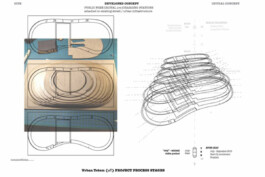Rabbithole Research
(rbt_h0l): Towards a Hybrid Modeling Technique in Architectur
Aileen Iversion
If the world were clear, art would not exist. - Camus, The Myth of Sisyphus, 1942
Function of Art.
All art, including architecture, functions as hypothesis: proposals for interpreting the world. As end products, (painting, sculpture, music, writing, photography, film, etc.) art embodies universal principles (time, space, nature, God, death, myth, etc.) precisely because it examines them. In this way art is able to resonate broadly irrespective of culture or time period and is therefore, while a product of its age, timelessly relevant.
Architectural design process.
In architectural practice this type of critical analysis-through-making (objects) is concentrated in architectural design processwhich emphasizes analysis as a physical engagement over purely conceptual or text-based method; and connects to the historic underpinnings of the architectural practice as a lineage of handcrafts: masonry, metal work, sculpture, etc.
Crisis.
However, in contemporary architectural practice, architecture design process is increasingly performed in an impoverished digital CAD environment dominated by visual information and devoid of real-world dynamic factors (gravity, weight, tension, compression, etc.), to say nothing of the resulting physical and spatial complexity occurring from their interaction. This situation is contributing to a crisis in contemporary architectural practice, specifically the crisis of the ability to create critical architectural form.
Contrapposto Hypothesis.
As antidote to this crisis this study postulates the ‘contrapposto hypothesis’: that complexity of form results from complexity of context, and is heavily influenced by Classical Greek and Roman sculpture, specifically in technique of contrapposto - an asymmetrical arrangement of the human figure in which the line of the arms and shoulders contrast with, while balancing, those of the hips and legs. Therefore contrapposto intentionally places the figure in an off-balanced pose - creating a dynamically charged, hyper-physical context of immediate engagement between figure and space; one requiring that the figure incorporate balance and multi-axial-rotations, producing a non-frontal, complete figure-in-the-round, multi-orientation. This is an extreme use of, and full engagement with, three-dimensional space in which space, the negative partner of form, is calibrated through the reactions recorded in the figure.
Doctorate Statement.
This doctorate study therefore will focus on enriching the digital design environment (3D CAD) by adding factors of complexity found in physical space (weight, gravity, balance, etc.). Furthermore, in order to bring physical aspects into the digital context this study will effectively generate a new modeling technique: a hybrid of digital-physical modeling and finds precedent for model-technique-invention in the works of Gaudí, Otto, and Bézier.
Conclusion.
While currently in a foundational stage, this doctoral study already sees profound implication into changing the way that architects interact with digital design, one that suggests a more tactile engagement with digital 3D design elements, such that these elements inform/ are in dialogue/ provide resistance and feedback - with respect to the design and returning analysis-as-making (art and architecture) to their function as defined by Camus - tools for examining the world.

Rabbithole Research
(rbt_h0l): Towards a Hybrid Modeling Technique in Architectur
If the world were clear, art would not exist. - Camus, The Myth of Sisyphus, 1942
Function of Art.
All art, including architecture, functions as hypothesis: proposals for interpreting the world. As end products, (painting, sculpture, music, writing, photography, film, etc.) art embodies universal principles (time, space, nature, God, death, myth, etc.) precisely because it examines them. In this way art is able to resonate broadly irrespective of culture or time period and is therefore, while a product of its age, timelessly relevant.
Architectural design process.
In architectural practice this type of critical analysis-through-making (objects) is concentrated in architectural design processwhich emphasizes analysis as a physical engagement over purely conceptual or text-based method; and connects to the historic underpinnings of the architectural practice as a lineage of handcrafts: masonry, metal work, sculpture, etc.
Crisis.
However, in contemporary architectural practice, architecture design process is increasingly performed in an impoverished digital CAD environment dominated by visual information and devoid of real-world dynamic factors (gravity, weight, tension, compression, etc.), to say nothing of the resulting physical and spatial complexity occurring from their interaction. This situation is contributing to a crisis in contemporary architectural practice, specifically the crisis of the ability to create critical architectural form.
Contrapposto Hypothesis.
As antidote to this crisis this study postulates the ‘contrapposto hypothesis’: that complexity of form results from complexity of context, and is heavily influenced by Classical Greek and Roman sculpture, specifically in technique of contrapposto - an asymmetrical arrangement of the human figure in which the line of the arms and shoulders contrast with, while balancing, those of the hips and legs. Therefore contrapposto intentionally places the figure in an off-balanced pose - creating a dynamically charged, hyper-physical context of immediate engagement between figure and space; one requiring that the figure incorporate balance and multi-axial-rotations, producing a non-frontal, complete figure-in-the-round, multi-orientation. This is an extreme use of, and full engagement with, three-dimensional space in which space, the negative partner of form, is calibrated through the reactions recorded in the figure.
Doctorate Statement.
This doctorate study therefore will focus on enriching the digital design environment (3D CAD) by adding factors of complexity found in physical space (weight, gravity, balance, etc.). Furthermore, in order to bring physical aspects into the digital context this study will effectively generate a new modeling technique: a hybrid of digital-physical modeling and finds precedent for model-technique-invention in the works of Gaudí, Otto, and Bézier.
Conclusion.
While currently in a foundational stage, this doctoral study already sees profound implication into changing the way that architects interact with digital design, one that suggests a more tactile engagement with digital 3D design elements, such that these elements inform/ are in dialogue/ provide resistance and feedback - with respect to the design and returning analysis-as-making (art and architecture) to their function as defined by Camus - tools for examining the world.
